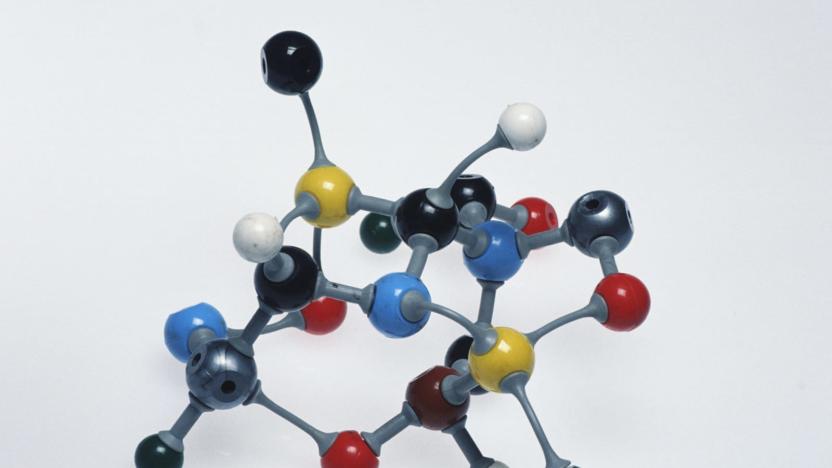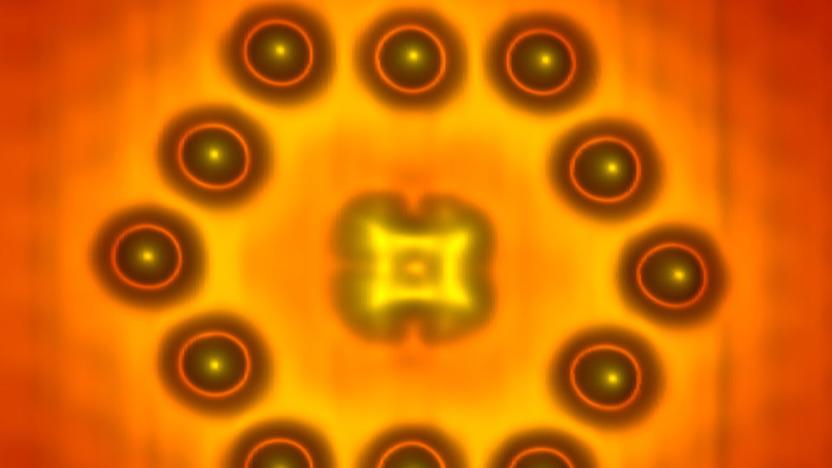molecules
Latest

Sony's FlavorGraph uses AI to predict which ingredients will pair together
AI has gone into games and self-driving with mixed success, but now it's trying its hand at cooking.

IBM shares AI tools to better understand and treat COVID-19
It has released a series of new tools to aggregate data, help researchers explore potential therapies, advance the study of newly sequenced SARS-CoV-2 genomes and make the latest info available to healthcare professionals. Its AI deep search tool is ingesting data from the White House, a coalition of research groups and licensed databases from the DrugBank, Clinicaltrials.gov and GenBank. The cloud-based research tool is a repository of genes, proteins and other molecules from sequenced viral and bacterial organisms, and it’s meant to help researchers identify molecular targets necessary for drug design, test development and treatment.

Molecule-level 'CT scans' could lead to faster drug discovery
Scientists like to use x-rays when determining chemical structures to develop drugs, but it's an agonizingly slow process. As they need large, pure crystals, it can take weeks or even years to produce something big enough for studying. However, that time might be cut down to a matter of minutes. Researchers have developed a CT scan-like technique that can quickly and easily detect the shape of very small organic molecules. It borrows elements of the x-ray technique, but doesn't demand the large crystals.

IBM's simulated molecule could lead to drug and energy advances
IBM's quantum computer has made a small advance that could ultimately lead to a major chemistry breakthrough. A team of IBM researchers has successfully used IBM Q to accurately simulate the molecular structure of beryllium hydride (BeH2), the largest molecule ever to be simulated by a quantum computer to date. This is pretty important, because simulating any molecule on a quantum level is no easy task, never mind a big one.

Scientists use molecular 'sieve' to purify water
Researchers have taken a major step forward in making previously undrinkable water drinkable, therefore tackling one of the biggest challenges faced by the planet -- some 1.2 billion people lack access to clean drinking water (a number which is set to grow as populations increase). By modifying graphene oxide membranes, the international team of researchers has created what is essentially a molecular "sieve". The selectively permeable membrane lets some molecules through while trapping others behind, producing water at various levels of cleanliness suitable for drinking or for industrial applications.

Crowdsourced research predicts what molecules smell like
As of now, the only way to tell how something smells is to actually take a sniff. That is to say, there's no observable, scientific measure we know of that can predict how we'll perceive a specific odor. In comparison, things are a little more cut and dried with sights and sounds; because humans use wavelengths to process what they see and hear, we generally agree on, say, how we expect a specific color to look. But scientists now seem to be making progress on the olfactory front: New crowdsourced research has brought scientists closer to predicting a molecule's smell based solely on its chemical properties.

Scientists build atom-scale sub that moves at 'breakneck' speeds
There are still no nanobots plying our bloodstreams, seeking and destroying cancer and other diseases. However, scientists at Rice University have just built a molecule-scale "submarine," so that's a pretty positive step towards "Fantastic Voyage." Mades at the same lab that developed "nanocars," the devices are a mere 244 atoms in size, with motors powered by ultraviolet light that turn at over a million RPM. That propels them along at a solid one inch per second, which is a "breakneck" pace according to lab director James Tour. "These are the fastest-moving molecules ever seen in solution," he said.

Scientists make a transistor from a single molecule
You're looking at what could be not just one of the smallest semiconductor parts ever, but one of the smallest semiconductor parts possible. A worldwide research team has built a transistor that consists of a single copper phthalocyanine molecule, a dozen indium atoms and an indium arsenide backing material. The trick was to abandon the usual mechanics of a transistor, which normally controls current by modulating the gate voltage, in favor of a field effect. Here, you only need to vary the distance of the gate (in this case, the atoms) to modulate electricity.

Scientists develop composite material to enhance device response time
Ever feel like your phone is taking an awfully long time to register that swipe to unlock? Well, scientists from Imperial College London and King Abdullah University of Science and Technology are developing a solution that could mean faster response times. By combining polymer semiconductors and small molecules into a composite material to make organic thin-film transistors -- a process known as composite collaboration -- they found a way to increase the speed of the electrical charge moving through a device's components. The end result could someday be a smartphone that reacts to your touch much more quickly than your current handset. If you're so inclined, jump below the break to the presser for a more in-depth explanation.

Visualized: International Year of Chemistry, in posters
Whatever Simon C Page sees in chemistry, we wish our high school teachers did as well. The aforesaid graphic artist has whipped up a smattering of eye-pleasing, mind-bending posters to commemorate the International Year of Chemistry 2011, and even if you can't tell your Hs from your 2s and Os, you owe it to yourself to give that source link a look. Enjoy.

Online gamers solve microbiology puzzle, contribute to anti-HIV solutions
Hey guys, look! Gamers are good for something! After struggling for some time to successfully map the structure of M-PMV, "a protein involved in a virus that causes a form of simian AIDS," scientists decided to hand the task off into more capable hands. Unfortunately, the only hands they could find were those of online gamers. Always willing to rise to a challenge, however, the gamers didn't disappoint. Through the use of a program called Foldit, which takes the mapping of molecular structures and transforms them into a sort of puzzle game, gamers (particularly a group calling themselves the Foldit Contenders) were able to successfully map the protein. Scientists hope that the crowdsourced solution can be used to design new drugs, such as treatments for HIV. Way to prove our worth to society, folks. You've made us proud.

NASA finds DNA components in meteorites, says they originated in space (video)
So, this is kinda wild: scientists at NASA have uncovered new evidence that DNA components found in meteorites can originate in space, lending new credence to the theory that life on Earth may have arisen from a pre-existing "kit" of materials delivered via asteroid. The discovery is outlined in a new paper from Dr. Michael Callahan, whose team of researchers closely analyzed samples from 12 different meteorites, using a mass spectrometer and liquid chromatography. In their samples, they found traces of adenine, guanine, and a variety of molecules known as nucleobase analogs -- including three that are rarely found on Earth. Scientists have long known that meteorites can contain DNA elements, but were unsure whether these materials actually originate in space. The presence of these three molecules, however, suggest that they do, potentially raising new questions about the dawn of life on Earth, and beyond. It's all quite heady, but steam ahead for a NASA video that might help clarify things, after the break.

Dutch scientists develop half million euro, 'affordable' super laser
The folks at Eindhoven University of Technology (TU/e) have lovingly referred to their latest contribution to the world of science as the "poor man's X-FEL." An X-FEL, or X-ray Free-electron Laser, is like a super strong video microscope that converts electrons to X-rays to observe high-speed molecular movement. TU/e's super laser alternative depends solely on a very specific bunching of electrons to do the same thing, allowing for a much smaller (it fits on a tabletop), much cheaper setup. With an estimated cost of half a million euro, the laser is hardly cheap, but it's far more affordable than the competition: Stanford's X-FEL runs hundreds of millions of dollars, and measures a whole kilometer. TU/e researchers admit that their laser can't do everything that an X-FEL can, but, hey, you get what you pay for. Up next for TU/e? In vitro pork products. Yummy.

Visualized: world's largest neutrino observatory rivals Guatemala sinkhole
Without question, one of the images from 2010 will be the insane, almost incomprehensible sinkhole that emerged in Guatemala earlier this year, but this particular shot from the South Pole does an outstanding job of vying for equal attention. Coming directly from the University of Wisconsin-Madison, this is a look into the planet's largest neutrino observatory, which was just completed after half a decade of work with $279 million. The goal? To detect "subatomic particles traveling near the speed of light," and when you have an ice-bound telescope that encompasses a cubic kilometer of Antarctic ice, well... you've high hopes for success. Will this pipe into the underworld finally lead us to understanding Dark Matter? Will century-old mysteries of the universe finally have answers? Even if not, we're envisioning a heck of an entry fee when it's converted into the world's longest firehouse pole and marketed to affluent tourists who make the trip down.

Researchers develop programmable molecular circuitry for living cells
Researchers at the UCSF School of Pharmacy's Department of Pharmaceutical Chemistry, led by Christopher A. Voigt have just published a paper which promises to get your circuits moving. The team has been working with E. coli bacteria to build logic gates like the ones found in computers directly into cells, making it possible to rewire and program them. The simple logic gates used in the experiment were built into genes then inserted into E. coli cells. The logic gates then acted as the communicator between the separate strains, allowing them to be connected together.The use of logic gates in cells could make it possible to tackle more complicated processes, so that science can begin to use cells at the molecular level for biomedical advances.

UTexas researchers develop organic battery, aim for week-long use in smartphones
Christopher Bielawski, a brilliant mind working at the University of Texas at Austin, had this to say about his newest discovery: "I would love it if my iPhone was thinner and lighter, and the battery lasted a month or even a week instead of a day; with an organic battery, it may be possible." Anyone that has ever owned an iPhone (or a smartphone or any sort, really) can grok just how bold those words are, but according to Mr. Bielawski, "we're now starting to get a handle on the fundamental chemistry needed to make this dream a commercial reality." At the center of this potential revolution is a newfangled organic battery recently detailed in the journal Science, but just as important is the artificial photosynthesis that the research also touches on. Bielawski and colleague Jonathan Sessler have seemingly figured out how to create an electron transfer process that can proceed in the opposite direction, with this forward and backward switching of electron flow opening up new avenues for the historically stagnant battery innovation market. Granted, these guys have yet to demonstrate that the process can occur in a condensed phase, so actual commercialization is probably a century millennium or two out, but hey -- at least our list of "awesome thing that'll probably never happen" has grown by one.

App of the Day: Subatomic for iPhone and iPad
App of the Day is TUAW's new App Store spotlight. One great app, every single day. Subatomic is a game that's available for the iPhone and the iPad. The premise is that you push molecules of different colors around a field with gravity. Portals sit on the gamefield full of molecules, and as they slowly fade away, it's your job to pull more in and match them up. By touching near a molecule, you can push it in a certain direction with a gravity vortex (the game has a cool blurred graphical feature whenever you touch the screen). The game ramps up pretty quickly; eventually you're trying to push molecules toward multiple portals while trying to keep different-colored molecules from reaching the wrong portals. Unfortunately, the difficulty curve can be a little high. It's sometimes hard to control the incoming molecules, and when you accidentally touch a little too close, you'll find yourself flinging molecules off into the distance instead of getting them where they want to go. At a basic level, though, it's an interesting control scheme that I haven't seen before. The game contains a full tutorial as part of its 31 levels, and the music and backgrounds (some of which contain actual electron microscope imagery from real-life scientists) add to the experience. The social features of the game are managed by OpenFeint. Subatomic is US$1.99 on the App Store, and a free version (with seven levels to try) is available as well.









